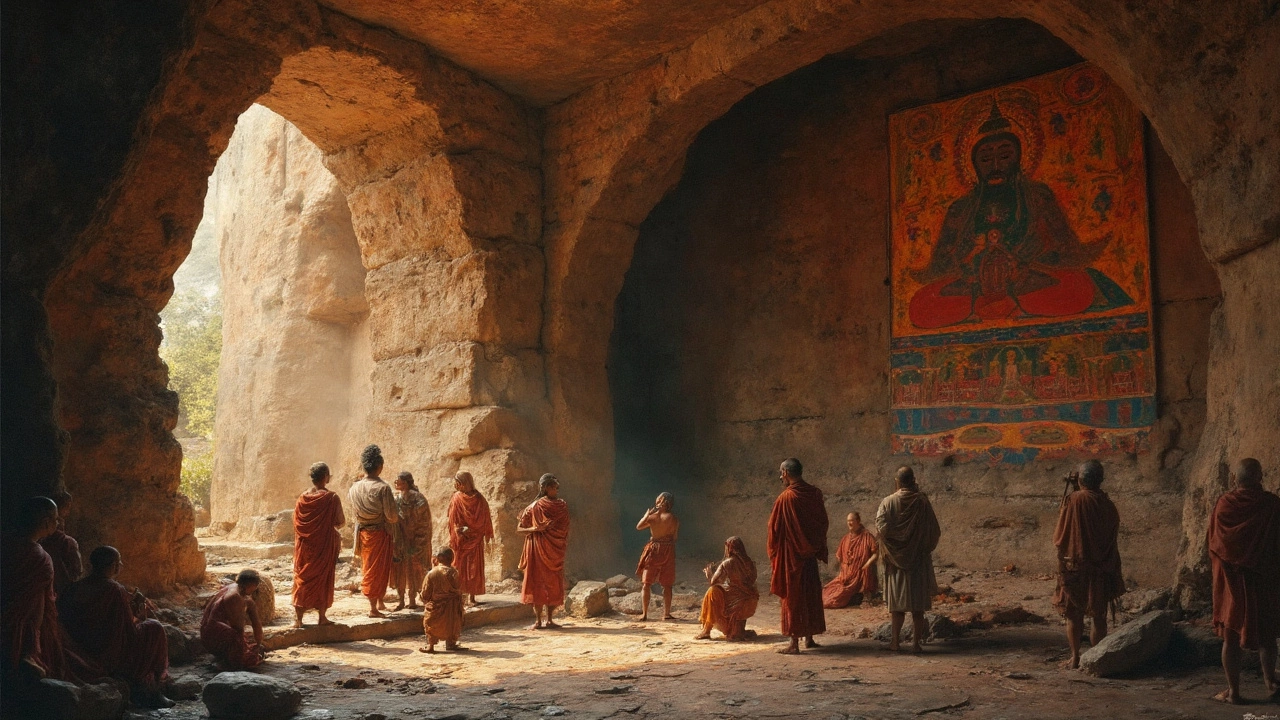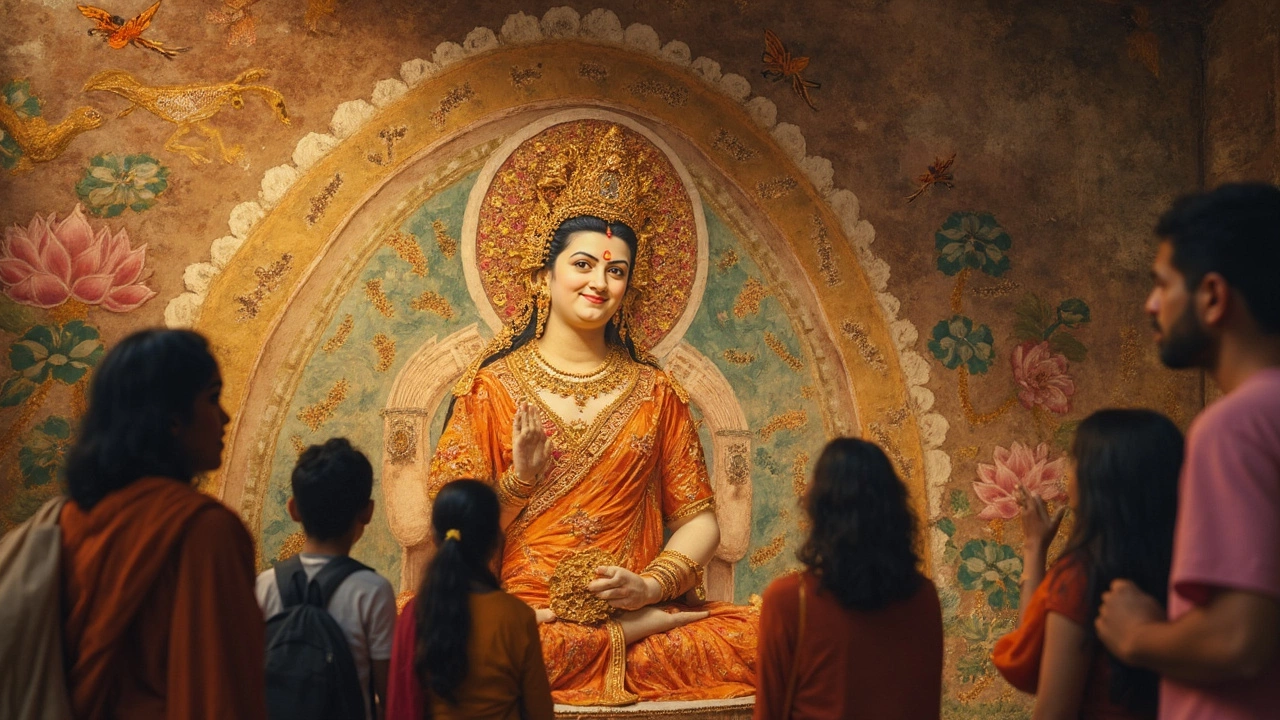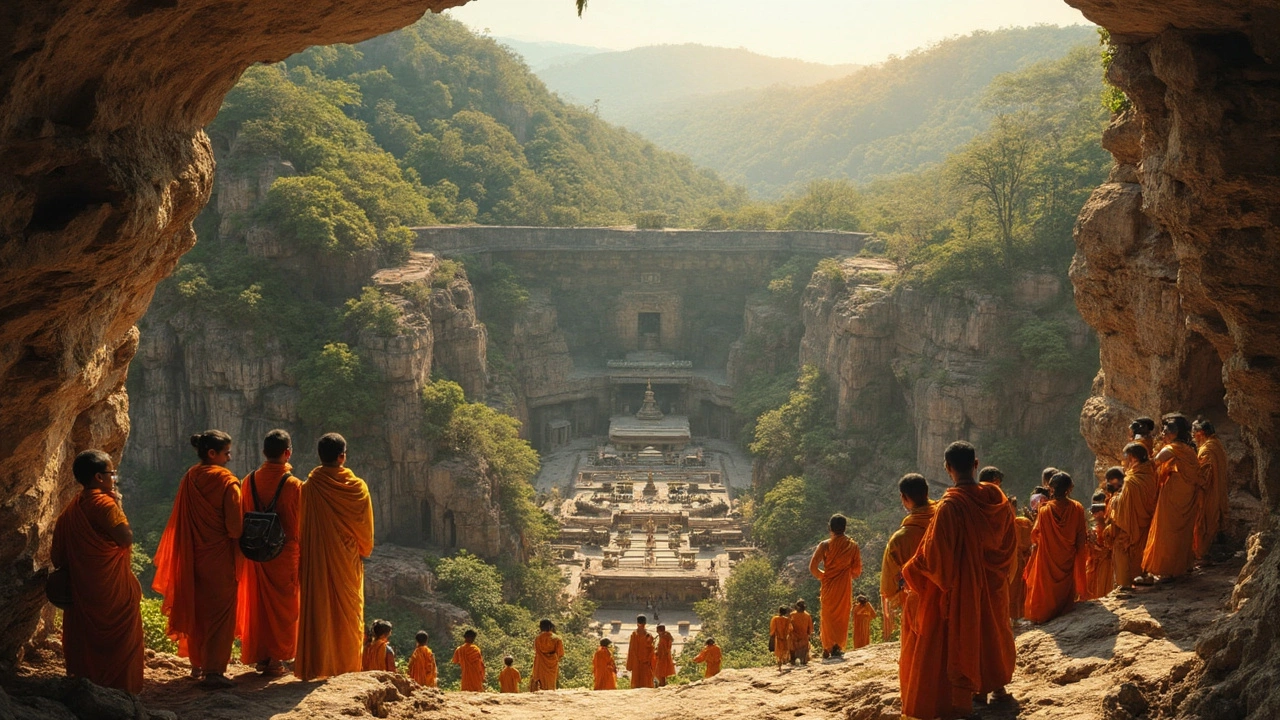You're staring at a wall—no, not just any wall. This one's covered in colors that have somehow survived nearly two thousand years. Imagine walking into a dark, cool rock cave in the middle of the Indian forest, somewhere around 200 CE. Candles flicker. An elephant painted in rich ochre seems to watch you. The walls are humming with stories. You're seeing the Ajanta Caves, and you’re smack in the middle of India’s first great masterpiece.
It blows the mind thinking about it. These caves, hidden away and eventually forgotten by the world, only to be rediscovered by a British officer in 1819 while out hunting tigers. What he found inside—murals of long-lashed kings, bejeweled dancers, and scenes from life and myth painted and carved into solid stone—kicked off a new way of seeing all of Indian art. Want to know what made these caves truly special and why artists and historians are still obsessed? Let’s dig in deeper.
The Birth of a Masterpiece: What Makes the Ajanta Caves Stand Out?
The Ajanta Caves lie in the Sahyadri hills near Aurangabad in Maharashtra, India. They're not just any caves. They’re man-made, carved laboriously into volcanic rock more than 2,200 years ago. Back then, working with rudimentary tools, Buddhist monks and artists shaped these gigantic caverns by hand. Take a second to picture the physical grind—chipping away stone in total darkness or by the faint shimmer of oil lamps, dust swirling in the air. This wasn’t just construction. This was devotion, sweat and art rolled into one.
Out of the 30 caves at Ajanta, most are tucked into a horseshoe-shaped cliff above a pristine river. Monks meditated, prayed, and probably swapped stories here for centuries. The Ajanta Caves aren’t one-hit wonders either. The oldest ones date back to the 2nd century BCE, with newer additions coming in around the 5th century CE. This timespan makes Ajanta a living museum, a time capsule of changing ideas and artistic flair.
The caves are packed with murals and sculptures that tell stories from the life of Buddha and tales from the Jatakas—ancient parables with morals, adventures, and even some wild animal cameos. Early cave murals like those in Cave 10 look different from later showstoppers in Cave 1 or 2. Early artists painted simpler figures, focusing on narrative. A few centuries later, their successors got bolder. Colors deepened, brushwork became fancier, and human faces came alive with personality. That’s where realism shines through—flickers of joy, compassion, or sorrow on those weathered faces on the walls. First masterpiece of Indian art is a title the caves wear with ease, considering the sheer ambition, scale, and technical skill on display.
Let’s not skip the sculptures. Chandeliers, pillars, elaborate ceilings, and serene stone Buddhas all demand equal attention. Here, stone wasn’t just chipped away. Layers of meaning got built up—each carving reflecting Buddhist ideas like compassion, humility, and the cycle of rebirth. This wasn’t just about prayer; it was art for the soul and stories for the eyes.
The Ajanta murals are particularly special because of their painting technique. Artists prepped the stone walls with layers of clay, cow dung, and rice husk, then smoothed everything out with a final layer of lime plaster before the brush ever touched it. They used natural pigments—lapis lazuli for blue, malachite for green, red ochre for those spicy reds—blending colors in ways even modern artists praise. No paints from Europe or fancy imported tools. All home-grown.

Ajanta’s Influence: How One Cave Changed Indian Art Forever
It’s not a stretch to say everything in Indian art circles back to Ajanta at some point. When the caves were rediscovered in the 19th century, European painters, Indian revivalists, and even poet Rabindranath Tagore found fresh inspiration. Young Indian painters from the Bengal School and Bombay schools in the early 20th century saw the Ajanta figures and wanted to start a new, modern Indian art that honored old traditions. They started borrowing Ajanta’s vivid storytelling and coloring tricks.
Ever wondered how Ajanta’s art stayed so fresh? The ancient artists didn’t just copy old formulas. They threw in dramatic gestures, experimented with shading, and mixed religious themes with daily life. Food banquets, royal processions, and street musicians—if it happened around them, the artists probably painted it. When you look closely, the Ajanta works aren’t stuck in the past. They feel shockingly now. Those characters stumble, laugh, and sometimes just slouch against a column, lost in thought. No strict poses or awkward, stiff glances. Everything feels as alive as the world outside your window.
Here’s a wild fact: Ajanta’s Buddhist art sparked a domino effect across Asia. Ancient traders and monks saw these paintings, fell in love with them, and took the style along the Silk Road. If you spot a mural in Dunhuang in China or in Bamiyan, Afghanistan, that looks familiar, thank the Ajanta artists. Their ideas of balanced composition, nature scenes, gentle facial features—these all traveled and got woven into other cultures’ work.
At home, Ajanta’s influence touched everything from temple building styles to how faces, bodies, and clothes were drawn in Indian miniature paintings. Later dynasties like the Chalukyas and Pallavas even had their artists visit the Ajanta caves for inspiration. Want proof? If you line up Ajanta frescoes with Deccan paintings from centuries later, the echoes are loud and clear.
Indian art hadn’t really seen this kind of action before. Before Ajanta, evidence of painting survives as delicate rock art at places like Bhimbetka, or on early pottery, but nothing approaching this scope, detail, or color. Ajanta didn’t just set the bar—it became the new standard. Ancient Indian artists were suddenly chasing bigger dreams, and the mural tradition that followed changed forever.

Tips for Seeing Ajanta Up Close—and What to Look For
If you want to see these marvels up close, don’t just sprint through the caves with your phone camera blazing. The colors are still there, but they’re fading, so you need time to really spot the details. The Indian Archaeological Survey put protections in place, limiting crowds and capping flash photography. So breathe. Stand back and scan the walls slowly. Here’s some useful stuff to know if you ever decide to visit, or just want to appreciate the Ajanta Caves more deeply from your screen:
- Go early in the morning. The caves get crowded fast, especially on weekends. Early hours mean softer light, fewer tourists, and a more peaceful vibe.
- Start at Cave 1 and 2—they’re the showstoppers with the most intact mural panels. Look for the famous Bodhisattva Padmapani, who’s become something of an Instagram favorite.
- Bring a guide or use an official recorded tour. There’s a lot packed into those stories, and a good guide will dig out myths, jokes, and ancient gossip that you might miss.
- Spend a moment in the prayer halls (Viharas). Try closing your eyes. Imagine the hum of monks chanting, stone cool beneath your feet, river wind in your ears. It brings history alive.
Take a magnifying glass if you’re a real detail nerd. Each mural is loaded with micro-details—necklaces, curls of hair, birds in the trees—which are easy to miss. The painter’s brushstrokes, surprisingly delicate, are visible if you look close. Sometimes you’ll even catch ancient graffiti judging or admiring the paintings. It’s a sneaky trail of real human connection across centuries.
Check the sculptures lining the cave entrances. Some figures are damaged (centuries of monsoon, earthquakes, and bats will do that), but the expressions are still there. Stand quietly. Look at the relaxed curves, the natural folds in the robes, and the soft smiles cast in stone. It’s a vibe you rarely get from any other place.
If you want numbers, here’s the quick data hit about Ajanta’s art that makes museum-goers worldwide stop and stare:
| Feature | Details |
|---|---|
| Total caves | 30 |
| Time Built | 2nd century BCE – 5th century CE |
| Murals | >600 painted panels |
| Sculptures | Dozens per cave; includes Buddhas, animals, ornamentation |
| Main pigment | Natural minerals: lapis, malachite, ochre, chalk |
| Rediscovered | 1819 CE |
And now? The Ajanta Caves are a UNESCO World Heritage Site, and restoration is always ongoing. Most experts agree: no matter what comes later in Indian art, Ajanta’s magic is impossible to top. Its blend of history, creativity, and sheer nerve is still drawing crowds—and inspiring artists—across the world. Even today, if you pick up a paintbrush and want to see what true genius looks like, those ancient cave walls are waiting for you.
